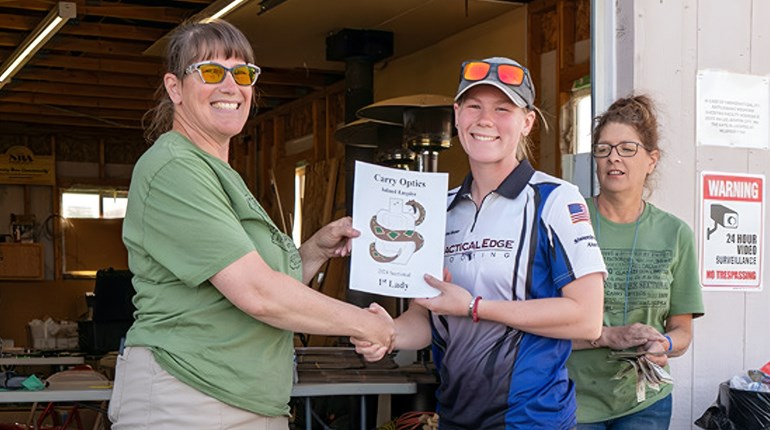
The fireworks, as they should, came at the end of a Joint Economic Committee hearing Wednesday in testimony from gun-control proponents and gun-rights supporters.
The first person to speak was Adam Skaggs, chief counsel and policy director of the gun-control group Giffords Law Center. Next up was Tina Meins, a member of the gun-control group Everytown Survivor Network. Third was Dr. Suzanna Hupp, a former member of the Texas House of Representatives who became a leading advocate for the individual’s right to carry a self-defense firearm after surviving the Luby’s shooting in 1991. Finally, Dr. John Lott, president of the pro-freedom Crime Prevention Research Center, got his five minutes.
These hearings are all done in the same basic way. There is typically a press table to the side in a committee-hearing room, and there was in this case. The public, which, of course, also includes the media—no one checks press credentials here and no one should, as in America we all have First Amendment rights—then fills in seats near the doors leading in. A long table for speakers who testify is in front of the public seats. The table faces wooden partitions, behind those are chairs and microphones—one for each congressman or woman on the respective committee.
Before these hearings begin, a committee staffer places stacks of the speaker’s prepared statements on the press table.
This is where the first big reveal, that the mainstream media would never spell out occurred.
The weight of these four peoples’ testimonies were very different.
Meins’ testimony was a short, emotional story about her father, Damian, who’d been murdered by the San Bernardino killers. Those two murderers were terrorists. Meins’ father was in a “gun-free zone.” For some reason, the lesson Meins got from this is that more law-abiding citizens should be disarmed.
Skaggs testimony was a short list of misinformation, such as, “Gun violence has an enormous human cost: approximately 36,000 people in this country are shot and killed each year,” which is basically true, except that he never explained that about two-thirds of these deaths are suicides and some others are justifiable homicides. (In 2016, for example, law enforcement reported 766 justifiable homicides to the FBI.) He also didn’t note the inconvenient fact (for him) that the homicide rate has actually fallen over the last three decades as gun sales have increased.
Hupp’s story was a personal and riveting narrative about why she supports our right to keep and bear arms. She explained that she couldn’t possibly read her entire testimony in the five minutes she’d been allotted. Instead, she would briefly explain what she went through when she reached for her purse only to remember that she had, in order to obey the law, left her self-defense gun “100 yards away” in her vehicle in 1991 when the murderer attacked. Both of her parents were murdered that day. She only survived by playing dead.
Lott’s testimony, meanwhile, seemed like the chapter of a history book from David McCullough. It was a long, detailed and heavily footnoted document.
So right there, before the hearing even began, was a stark juxtaposition of reason vs. emotion and misinformation.
The hearing began with Vice Chair Carolyn B. Maloney (D-N.Y.) pointing to a poster-sized chart showing (or rather purporting to show) that U.S. homicide rates far surpass other “high-income nations.” (Lott later wouldn’t endear himself to the very anti-gun Maloney by pointing out that her chart was based on very erroneous data.)
The gun-control representatives from Everytown and Giffords spoke first. They advocated for so-called “universal-background-check laws” and other gun-control laws, but didn’t add anything new to the debate.
Next came Hupp. After telling her story, she said, “Please consider the high-cost of gun control…. I reached for my gun, but my gun was 100 yards away dutifully left in my vehicle.… I can tell you that the cost of gun control was my parents and 23 innocent lives.”
Hupp asked rhetorically, “Why aren’t we seeing any of these mass murders at NRA conventions or at gun ranges?”
When later asked what Congress can do, Hupp said, “Rid us of gun-free zones.”
Lott did his testimony with a slide show. He covered a lot of ground in his five minutes, but when the clock on a wall by the entrance reached zero, Rep. Maloney stopped him.
Sen. Mike Lee (R-Utah) represented the Republican side and he did make pro-freedom remarks. Lee, however, had to leave to vote, and it was then that the hearing turned into a one-sided, anti-gun event.
Maloney, and other Democrats, asked questions of the gun-control representatives and ignored Hupp and Lott. Even when Skaggs (who is with Giffords) and Meins (with Everytown) attacked Lott personally, Rep. Maloney wouldn’t allow Lott to respond.
“You can put it in writing,” said Rep. Maloney to Lott as she waved away his attempt to defend himself.
“Other committees have let me reply when I’ve been attacked,” said Lott.
Maloney said, “People have schedules.”
There were some strange claims made in the Q&A period; for example, Skaggs said that someone who fails a background check can simply go onto many websites to “choose from millions of guns” and could then later buy the gun in “some parking lot.” He then claimed that a “universal-background-check law” would somehow stop already illegal sales to prohibited persons. He didn’t seem to understand that law enforcement needs to arrest those who sell guns illegally and then prosecutors need to push for convictions.
When Sen. Lee made it back from voting, he gave Lott the opportunity to defend himself by giving Lott his five minutes. Lott did so. But what was interesting was that a group of gun-control activists (all wearing red “Moms Demand Action” T-shirts) broke the rules of the hearing by hissing and shouting as Lott spoke. Rep. Maloney, who was running the hearing, never did anything about this.
The scene went on as a microcosm of American politics on this issue. Gun-control activists were given the majority of the time and when their spin was pointed out, they attacked Lott personally instead of defending their ideas. It was as if Lott and Hupp were trying to have a mature discussion with emotional extremists—well no, it wasn’t like that, it was precisely that.
After the hearing, as previously noted, came the fireworks.
Two of the Moms Demand Action activists approached Lott as he packed up his papers. One screamed at him, “You’re evil.” The other asked where he lived. When Lott asked why she wanted to know, she said, “I am going to come to your house to show your children pictures of people killed by guns.”
Lott said, “I am not going to let you come and threaten my family.”
The gun-control activist then started shouting that she wasn’t going to threaten them.
“How about showing photos of people killed who’d been turned into disarmed victims by gun-control laws,” said Lott, but by then the Mom Demand Action activists were red-faced and shouting that they’re not threatening anyone.
Hupp asked a police officer to move up to dispel the activists and the fireworks were over.
In the end, anyone paying attention must have noticed that if this issue is stuck, it is because the gun-control side can’t handle a rational discussion.
(Frank Miniter’s latest book is The Ultimate Man’s Survival Guide to the Workplace.)


































